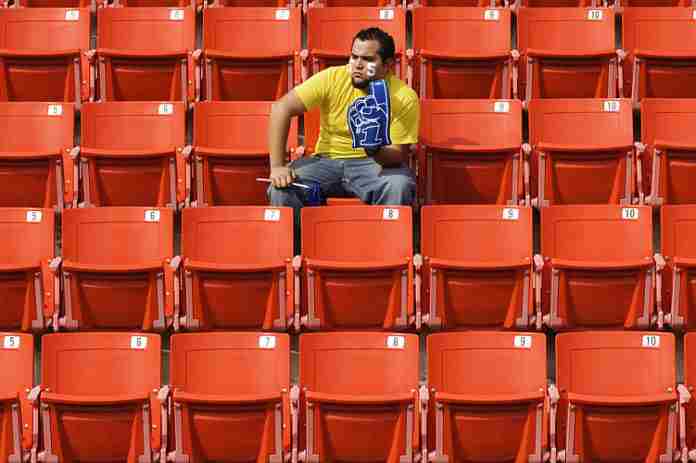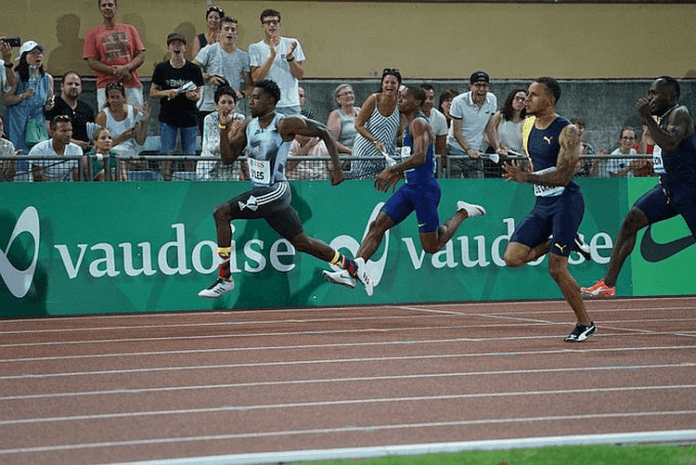People who care deeply about track & field in the United States decry the low profile the sport has today. The symptoms are obvious: meets are poorly attended, there is too little promotion and only passing interest from television or even online services which every Olympic sport thinks will be their savior.
At the same time, we have seen the rise during the last few years of a brutal spectacle called the Ultimate Fighting Championship (UFC), which is classified as a Mixed Martial Arts “promotion company” in the style of old-style boxing, or even more accurately, professional wrestling. This program of MMA fights has become a huge industry, with millions of fans and gross revenues of more than $600 million in 2018.
Why can’t track & field, the highest-profile sport in the highest-profile sporting event in the world – the Olympic Games – do something like that, or at least much better than it is doing now?
(The folks at the International Swimming League, trying to launch a city-based team vs. team concept, have asked the same question).
Fingers have been pointed at governing bodies, whether the IAAF at the international level, or USA Track & Field at the national level. Stop wasting your time; while both are well intentioned, neither has an answer, let alone the answer.
And that’s because neither the IAAF or USATF is what all of the other successful entities in this space require: a “promotion company.” Wikipedia defines such an entity as:
“An entertainment promoter works in entertainment industries, including music and sports, as an individual or organization in the business of marketing and promoting live, or pay-per-view and similar, events, such as concerts/gigs, sports events, festivals, raves, and nightclub performances.”
That’s not what a governing body is for. Track & field has no such organizations at work to promote the sport worldwide, or even nationally in the U.S. There are individual meet directors, many of whom are part of institutions, such as the highly-respected Dave Johnson for the Penn Relays at the University of Pennsylvania. But the true independent meet promoter is a rare bird these days. The Nike Prefontaine Classic, headed by Tom Jordan, does one meet a year.
Long gone are serial promoters such as Al Franken, who put on two indoor meets and two outdoor meets a year in California, out of his own pocket. He recruited the sponsors – whose names became synonymous with the sport, such as Sunkist, Jack in the Box, Pepsi and Foot Locker – and then rented the venues, signed up the athletes and doggedly pursued newspapers and television stations in the local market for publicity. For more than 30 years he succeeded, but when the sponsorship market was more focused on national, rather than local, programs, his meets died.
Today’s media environment is now so saturated that it’s unlikely that many such local meets can survive, outside of legacy events like the Texas-Penn-Drake-Mt. SAC relays. In the U.S., and increasingly elsewhere, media exposure is now of national or global reach. And look what the promoters of successful programs do.
If you’re Major League Baseball, you’re playing games in as many other countries as you can book … plus a game at the home of the Little League World Series each year and now, at the famed “Field of Dreams” site in Iowa. The National Football League is playing – or trying to play – in Great Britain, Germany, Mexico and looking for more sites. The National Basketball Association and National Hockey League have entire departments looking at overseas opportunities; the NBA is helping to form a new league in Africa, featuring 12 club teams that will start play next year.
What all of these groups, as well as the organizations promoting professional golf and tennis, have embraced, is the year-round calendar. Let’s look at UFC again:
● Its 2019 fight calendar has a fight card on 42 weeks of the year, with one featured match above all others, but with significant undercards, usually 12-13 fights in all. (Hmmm, there are 14 Diamond League events in Saturday’s Meeting de Paris; interesting.)
● Once a month is a numbered UFC card – such as “UFC 241: Cormier vs. Miocic 2″ at the Honda Center in Anaheim last Saturday (17th) – which has a higher level of promotion and helps to draw interest that supports the other 40 cards held each year.
Because a single organization is behind this program, it has recurring expertise in promoting its fights and creates continuity from show to show. This is not a new concept to track & field; check out this excerpt from the 8 March 1970 edition of The New York Times about the Amateur Athletic Union of the U.S., in its original form:
“For the second consecutive year, a series of 17 A.A.U. outdoor international track and field meets, including the national championships at Bakersfield, Calif., and the United States- Soviet meet at Leningrad, will be presented in color on the C.B.S. Television Network beginning May 17.
“The program will be broadcast for an hour each Sunday afternoon through Sept. 6, except on June 28 and July 26 when it will be expanded to 90 minutes for coverage of the A.A.U. national championships and the U.S.-U.S.S.R. meet.
“Jack Whitaker will be the host.
“The Martin Luther King Games at Villanova, Pa., will start the series. On seven Sundays thereafter, meets in California and Oregon will be presented. The series will then move to Europe for nine broadcasts originating in Leningrad, Paris, Stuttgart, Cologne, Malmo (Sweden), Oslo, Warsaw, and a city yet to be selected.”
Continuity is the key and it’s what drives television rights sales and sponsorship. But to have something like this in track & field, it has to start with the athletes.
And what athletes are willing, today, to compete all-year round, or at least most of the year? Up until now, the world leaders in the men’s 100 m, 200 m and 400 m have competed in just 6-8 meets each: Christian Coleman (six), Noah Lyles (eight so far) and Michael Norman (six).
In 1975, the year before the Olympic Games in Montreal, no. 1-ranked Steve Williams of the U.S. ran in 14 meets in the 100 m and a couple more in the 200 m. Mile world-record setter John Walker of New Zealand ran 19 races in the 800 m, 1,500 m/mile and 2,000 m. No. 1-ranked high jumper Dwight Stones competed 20 times – outdoors! – in addition to a heavy indoor schedule. Shot putter Al Feuerbach similarly was in 18 outdoor meets alone, not to mention the indoor season. By the way, they all got paid, but at that time, under the table.
What athletes are willing to undertake that kind of show business today? An exciting young talent like Sydney McLaughlin has been in seven meets (indoors included) and world-record setter Dalilah Muhammad, in eight, so far this season.
Coaches, agents and managers won’t hear of 1970s workloads today, fearing especially that it will hurt performances in the only two meets anyone actually cares about each year: the national qualifier for the Olympic Games or World Championships, and then the World Championships or the Olympic Games.
Somehow, sports that are individually focused like golf, tennis and MMA have managed to thrive without the Olympic Games or a world championship. In fact, tennis and golf were invited back to the Games because they were so popular on their own. (Consider also road running, which took off without any management help from the International Olympic Committee or the IAAF.)
So let’s accept track & field (and swimming) as it is. An excellent, exciting sport for those who care, presented in a scattered format with a few meets across many weeks and months. There is more interest during Olympic years, but the sport does not have the structure, promoters or drive to organize itself – starting with the athletes as a group – to present itself as a cogent entertainment program as the UFC has managed over just this past 17 years.
UFC’s rise has hardly been without incident; if you will take an hour to read the Wikipedia entry about it, its growing pains and near-death experiences show the risks and difficulties involved.
But a cogent calendar, devoted promotional efforts and finding the right people to play has served every successful sports entity well on the way to becoming a success for the promoters, players, broadcasters and an expanding worldwide audience.
Track and field had it once, well before the UFC was ever heard of, and when the NFL, NBA and NHL were minor successes, fighting for attention behind the behemoth that was baseball. But that was then. I’m just glad I was around to enjoy it.
Rich Perelman
Editor



























